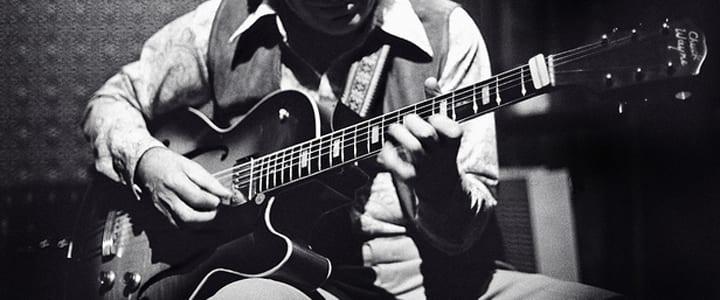 Whether you’re a jazz nut or not, these jazz guitar chords can add a whole new level of richness to your repertoire. Guitar teacher Jerry W. shares the 7 types of chords you’ll need to know…
Whether you’re a jazz nut or not, these jazz guitar chords can add a whole new level of richness to your repertoire. Guitar teacher Jerry W. shares the 7 types of chords you’ll need to know…
So you are getting tired of playing only major chords and the occasional minor chord? You would like to add more flavor to your playing by adding some jazzy guitar chords. Excellent! Let me introduce you to 14 common jazz chords you can begin to use in your music.
If I were to show you all possible chord charts for all seven chords it would be more than this post could cover. So what I am going to do is show you the most common open positions for these 14 types of chords and how you might use them.
What Guitar Chords Are Used in Jazz?
Although you can use a wide variety of chords when playing jazz guitar, there are a few that stand out in more songs than others. These include:
- The Major 7 Chord
- The Add 9 Chord
- The Major 9 Chord
- The Major 6 Chord
- The Minor 7 Chord
- The Minor 9 Chord
- The Dominant 9 Chord
Here’s a video that will explain more guitar chord basics for all styles of music for you:
What Makes a Chord a Jazz Chord?
Jazz guitar is a style of guitar playing that uses jazz chords and jazz guitar chord progressions. The rhythm changes may indicate a jazz style of playing, too.
Most, though not all, jazz chords have sevenths added to them. For example, if you are playing a G chord, it might turn into a G7 chord for jazz guitar playing.
The chord melody jazz guitar players must master can be a bit tricky, but the right guidance can make all the difference.
We’ll walk you through everything you need to know in this post, but the best way to get personally-tailored advice as you’re learning how to play jazz guitar is to get the help of a seasoned expert.Sign up for online and live guitar lessons here!
What Chords Are Mostly Used in Jazz? 7 Top Jazz Chords to Learn
These advanced jazz guitar chords will help you make the most of any jazz song you want to play. We have included helpful jazz chords guitar chart for easy learning.
1. The Major 7 Chord (maj7)
The major 7 chord can be used to replace the I chord or the IV chord in major keys. As a quick theory reminder, the chord number refers to the scale tone the chord is built upon. So for instance the C and F chords in the key of C. (They are the 1st and 4th scale notes in a C major scale.) Here are six open position major 7 chords you can play.

Here is the chord progression I-IV-I-V-I in a few keys to show you how it works:
Key of C: Cmaj7 – Fmaj7 – Cmaj7 – G7 – Cmaj7
Key of G: Gmaj7 – Cmaj7 – Gmaj7 – D7 – Gmaj7
D: Dmaj7 – Gmaj7 – Dmaj7 – A7 – Dmaj7
Key of A: Amaj7 – Dmaj7 – Amaj7 – E7 – Amaj7
Notice that the V chord is a dominant 7 chord not a maj7 (i.e. G7 not Gmaj7.)
2. The Add 9 Chord (add9)
The add 9 chord, like the major 6 can be used to replace most major chords. Here are some examples of open position add 9 chords.

The D chord in this example is actually a D2 chord because it is missing the 3rd of the chord, but it can function in the same way. Here is the chord progression I-IV-V-I in a few keys to show you how it works.
Key of C: C(add9) – F(add9) – G(add9) – C(add9)
Key of G: G(add9) – C(add9) – D7 – G(add9)
D: D2 – G(add9) – A(add9) – D2
Key of A: A(add9) – D2 – E(add9) – A(add9)
3. The Major 9 Chord (maj9)
The major 9 chord is almost identical to the add 9 chord except we have both the 7th and 9th in the chord. Here are some examples of open position major 9 chords.

Here is the chord progression I-IV-V-I in a few keys to show you how it works. I have mixed major 7 and major 9 chords so you can practice both.
Key of C: Cmaj9 – Fmaj7 – G(add9) – Cmaj9
Key of G: Gmaj9 – Cmaj7 – D2 – Gmaj9
D: Dmaj9 – Gmaj7 – A(add9) – Dmaj9
Key of A: Amaj9 – Dmaj7 – E(add9) – Amaj9
4. The Major 6 Chord (6)
The major 6 chord can be used to replace almost any major chord. Here are the six most common open position major 6 chords.

Here is the chord progression I-IV-V-I in a few keys to show you how it works:
Key of C: C6 – F6 – G6 – C6
Key of G: G6 – C6 – D6 – G6
D: D6 – G6 – A6 – D6
Key of A: A6 – D6 – E6 – A6
You may want to compare this to the sound of the same progression using the major 9 chords above. Also, if you replace the V chord with a V7 chord you will find the progression has a stronger pull back to I.
5. The Minor 7 Chord (m7)
The minor 7 chord can be used to replace most minor chords. As an added benefit, the minor 7 built off from the ii chord can also be used to replace the IV chord. Here are five open position minor 7 chords.

Here is the chord progression vi-ii-V-I in a few keys to show you how it works:
Key of C: Am7 – Dm7 – G7 – Cmaj7
Key of G: Em7 – Am7 – D7 – Gmaj7
D: Bm7 – Em7 – A7 – Dmaj7
Key of A: F#m7 – Bm7 – E7 – Amaj7
6. The Minor 9 Chord (m9)
The minor 9 chord can be used to replace the ii chord or vi chord in major keys. Here are some examples of open position minor 9 chords.

Note: the Dm(add9) is not a true minor 9 chord because it is missing the 3rd of the chord and is therefore a little less dissonant, but it will function in the same way. Here is the chord progression vi-ii-V-I in a few keys to show you how it works:
Key of C: Am9 – Dm(add9) – G7 – Cmaj9
Key of G: Em9 – Am9 – D7 – Gmaj9
D: Bm9 – Em9 – A7 – Dmaj9
Key of A: F#m7 – Bm9 – E7 – Amaj9
7. The Dominant 9 Chord (V9)
The dominant 9 chord can be used to replace a V chord. Here are some examples of open position dominant 9 chords.

Here is the chord progression vi-ii-V-I in a few keys to show you how it works:
Key of C: Am9 – Dm(add9) – G9 – Cmaj9
Key of G: Em9 – Am9 – D9 – Gmaj9
D: Bm9 – Em9 – A9 – Dmaj9
Key of A: F#m7 – Bm9 – E9 – Amaj9
7 More Jazz Guitar Chords
There are plenty of other guitar chords jazz that you can learn, too.
Jazz guitar chords are broken down with four notes (usually the root, third, fifth, and seventh) and can be categorized into several types.
Some other examples include:
- Dominant 7 (1 – 3 – 5 – b7)
- m7b5 (half-diminished) (1 – b3 – b5 – b7)
- Diminished 7 (1 – b3 – b5 – bb7)
- Major Augmented 7 (1 – 3 – #5 – 7)
- Dominant 7 Augmented (1 – 3 – #5 – b7)
- Minor Major 7 (1 – b3 – 5 – 7)
- 7sus4 (1 – 4 – 5 – b7)
Get started with jazz lessons on the guitar today to learn all of these fun chords – and then some!
Easy Jazz Guitar Chords for Any Player
I hope this introduction into some common open position jazz guitar chords such as fmaj7 add9 and dmaj7 chord has sparked your interest in the beauty and variety available in these chords. By using your capo you can take these chords and extend them into any key. Or you may wish to study the moveable versions of each of these chords so you can use them in higher positions on the guitar.
It might help for you to look at a jazz chords guitar chart as you’re learning how to play these jazz chord progressions guitar players everywhere should know, too. Here’s a helpful example.
Keep practicing and you will have mastered a whole new universe of chords, sounds and styles – and you’ll become a great jazz guitarist to boot!
Looking for one-on-one instruction? Whether you’re a beginner, intermediate, or advanced guitarist there is always more to learn, and a great teacher can help guide you to the next level in your playing. Search for a guitar teacher today!
 Jerry W. teaches classical guitar, composition, trombone and trumpet in Grosse Pointe, MI. He received his Bachelor of Music in Theory and Composition from Cornerstone University and went on to receive both his Masters and PhD in Music Composition from Michigan State University. Jerry has been making music and teaching students for over thirty years. Learn more about Jerry W. here!
Jerry W. teaches classical guitar, composition, trombone and trumpet in Grosse Pointe, MI. He received his Bachelor of Music in Theory and Composition from Cornerstone University and went on to receive both his Masters and PhD in Music Composition from Michigan State University. Jerry has been making music and teaching students for over thirty years. Learn more about Jerry W. here!
Photo by Tom Marcello
Megan L.






